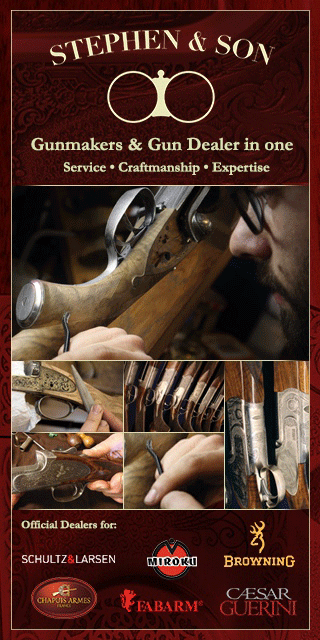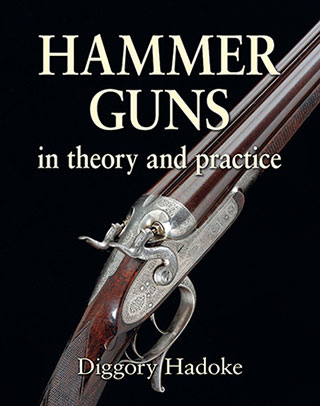‘First Do No Harm’. The much quoted-essence of the Hippocratic Oath is not actually in it!
The words are certainly attributed to Hippocrates but appear in another work: Of the Epidemics, in which he begs medical practitioners; ‘…with regard to disease, namely to do good, or to do no harm’.
These words are appropriate ones with which to begin a discussion on home gun-smithing. The guns you may be planning to work on were made by time-served craftsmen at the top of their game. Time may have been unkind to their creations but unskilled restoration or repair work is the unkindest cut of all, to paraphrase a line from Julius Caesar.

As a frequent buyer and restorer of century, or more, old sporting guns, the bodgery of tight-fisted former owners, or those with delusions of their own adequacy in the workshop, is a common frustration.
In the case of a best-quality gun, it requires very little effort to ruin it. Every aspect of the gun was made as it was, according to very strict criteria. Any deviation will attract the eye of the knowledgeable and remove it from their purchase list immediately.
If you are really determined to ruin a good gun, have a go at re-chequering. This is, without doubt, the fastest way to convert a £10,000 gun into a £5,000 gun in an effort to save yourself the £150 a professional will charge you to re-chequer a stock and forend.
if you mess chequering up, you can’t do much about it
The thing about chequering is that if you mess it up, you can’t do much about it. Every cut makes the hand thinner, if you have to file-off bad chequering and start again, you re-start with a significantly slimmer and weaker, and weird-looking piece of wood.
Skilled men make chequering look easy and the tools can be bought on-line. It looks like simply scratching lines on a bit of wood. This is why so many hobbyists feel emboldened to have a go. This is why so many used guns are ruined and need re-stocking.
After decades in the gun trade, appraising and handling tens of thousands of Victorian and Edwardian shotguns and rifles, one gets a sense of what looks imperceptibly right and what looks wrong.

This is something of a curse, because it means when a very competent, enthusiastic (and actually skilled) hobbyist shows me their re-stocking job on a nice Birmingham boxlock, something that has been a labour of love and a showcase for their talents, despite the shiny finish, the figured wood and the well-fitted wood-to-metal intersections, it screams ‘awful’ to me. Invariably something is ‘wrong’.
Maybe the finish is too shiny, maybe they didn’t use enough red oil, maybe the chequer panels are the wrong shape for the model, or the graduation from head to hand just lacks the line a professional would have achieved. Having carpentry skills does not make you a gun stocker. The devil is, indeed, invariably in the detail.
The reader may get the distinct impression from this that I am no advocate of hobbyist gunsmiths and he would be right. However, there are tasks that a modestly equipped gun owner might consider enjoyable to undertake himself. It may be that he has got hold of a cheap gun at auction or privately and would like to try his hand at disassembling it, cleaning it and re-assembling it.
If all goes according to plan, this can be done on a basic workbench with a few screwdrivers (turn-screws in gun trade parlance), a small hammer, a drift and (the one specialist tool) a spring-clamp.
With these, it should be possible to dismantle the gun entirely. Be warned, however, that if done without due care and competence, even this simple exercise can lead to burred screw heads, where a slippage has caused damage or a slot has been opened-up to allow use of a fatter screw-driver.
Having carpentry skills does not make you a gun stocker
A lot of these efforts get brought in at the ‘I give up’ stage, where the owner has encountered a seized breech pin or burred one too many slots and realises he is only going to make it worse if he continues.
Skipping that, we each have to be honest about our capabilities and experience. Practice on an old, low-value gun first. I learned the basics stripping barn finds my childhood friends used to bring me when I was a teenager.
So, what would I advocate the average sportsmen undertake on his own? Let us consider the concept of the hand-detachable lock. It is a great idea. It enables the amateur to remove the locks of his gun without tools, in order to clean them, thereby minimising the possible damage he can do.

With regard to the two main embodiments of the concept, as applied to side-locks and boxlocks, the former is the least satisfactory. The Holland & Holland system with the lever on the end of the lock pin, enabling the sportsman, merely by force of his thumb and fore-finger, to un-screw it and then tap-out the locks is potentially useful. It does enable quick and easy removal, inspection, cleaning and lubricating to be undertaken in the field or in camp or in the gun room.
However, even a simple task like this leads to issues. Many an enthusiastic chap has dropped out his locks to show his friends or amuse himself, only to get stuck putting them back in. It is important to align the ends of the cocking dogs and push the trigger-blades forward before re-inserting the locks, otherwise they won’t seat properly.
Then, there is the tendency for the pins to work loose when put-in and pulled-out of a gun slip, leading to the lock falling out: invariably onto a ploughed field and being trodden on!
The Westley Richards version, the hand-detachable boxlock is more fool proof. A hinged bottom-plate can be opened to reveal the ‘guts’ of the action; the limbs of the boxlock mounted on a side-plate and inserted from below. The hinge cannot open unless the forend is removed first, making it safe in the field. The lock still needs to be replaced carefully, making sure the whole mechanism hasn’t slid slightly upward on the tumbler pivot, preventing it from seating. All this is straightforward to the experienced but disconcerting to the tyro.

Even these simple operations require some basic skills and knowledge in order to not do any harm.
As we near the end of this article on home gun-smithing. I can perhaps best sum-up my advice thus; don’t do it.
There is a reason that people have professions and when it comes to keeping your valuable gun in good fettle, we are fortunate that we still have men (and one or two women) who are willing, and very able, to do the work for us. Britain is still home to the finest gun-smiths in the world.
They deserve our patronage and, believe me, you do not want to find yourself standing in a workshop, under the withering gaze of a veteran gunmaker, explaining that you now need him to rescue your gun from the mess you made trying to save yourself a couple of hundred quid.
What you can do at Home
Keeping your gun is good order actually means it will need less ‘gun-smithing’ during its life.
The first best thing you can do is take it out of the gun-slip as soon as you get home from shooting. Damp guns in damp slips lose their finish and go rusty fast.
Then take the damp gun apart and wipe it over with kitchen towel to remove any visible moisture. Push some wadded-up kitchen towel through the bores with a cleaning rod to remove any residue and then put the barrels on top of a warm radiator (not the forend or the stock).
Rub the wood over with a clean soft cloth and leave it to stand in a warm room to dry off naturally. Once dry, scrub the bores with the phosphor bronze brush and swab them out with kitchen towel, the last time soak the towel in gun oil. if it comes out clean, then swab the bore with a wool mop soaked in oil.
Metal parts need a dab of grease on bearing surfaces (hinge pin, bolts, hook). I use vaseline mixed with gun oil. Then wipe over the metal surfaces with a slightly oily cloth, taking care not to get oil on the wood.
These simple steps will prevent a lot of the wear and tear that befalls guns while not in use.
Published by Vintage Guns Ltd on (modified )



